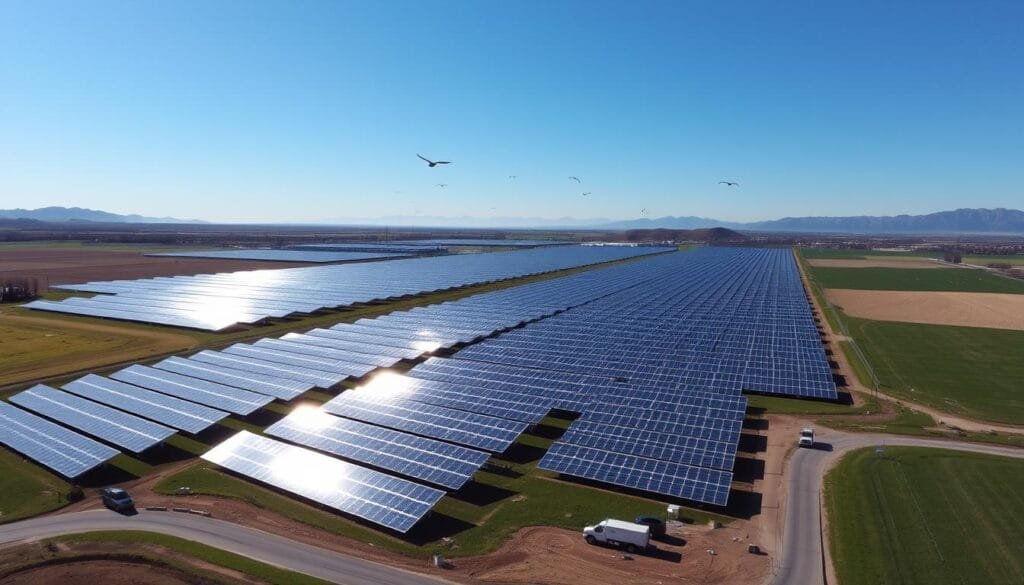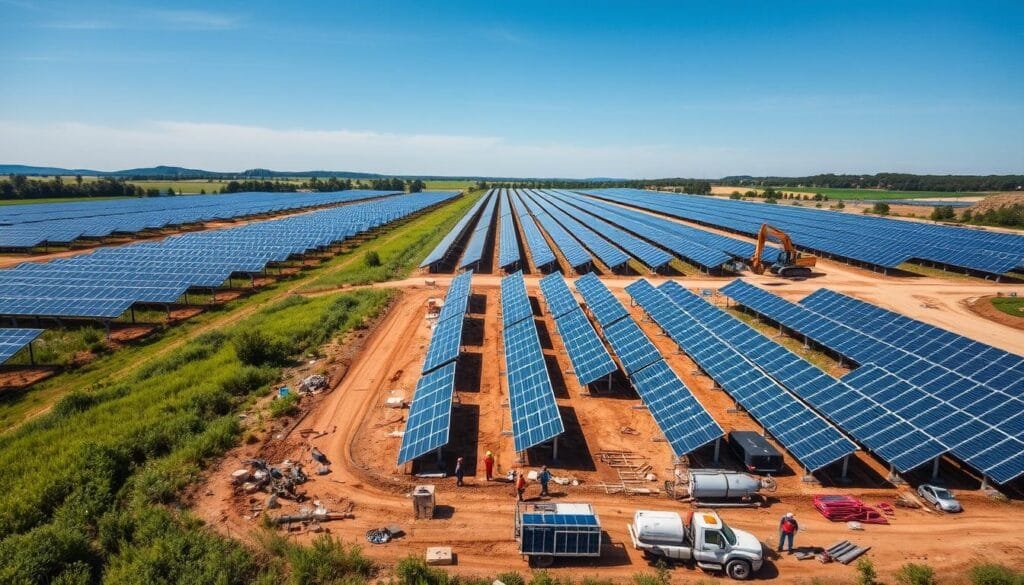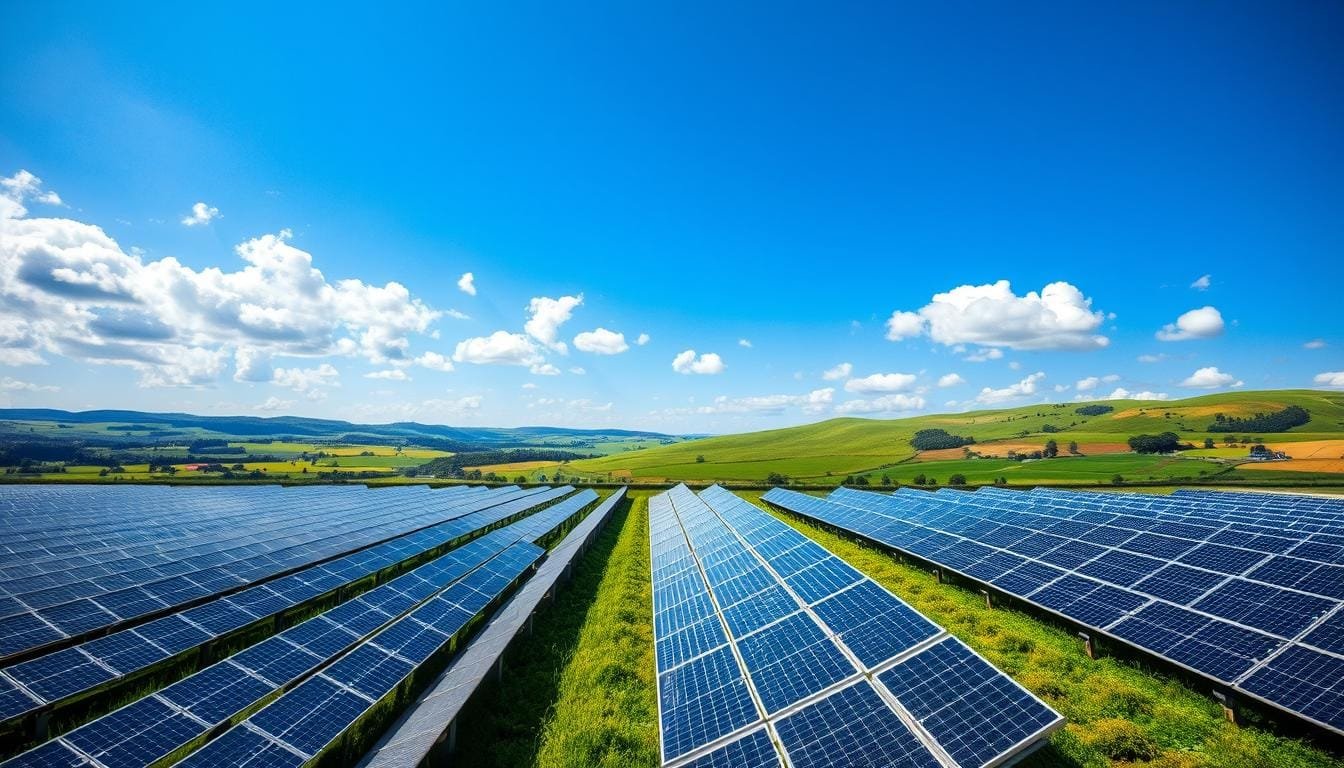Did you know the U.S. wants to double solar energy by 2030? This goal is to make electricity cleaner by 2035. Solar farms are changing how we make electricity, making it cleaner across the country.
So, what are solar farms? They are big areas with photovoltaic panels that catch sunlight and turn it into electricity. These farms cover many acres and are key in moving to sustainable energy. They use land that was once for farming to power our homes.
The U.S. has over 37,000 MW of solar projects now. And there’s another 112,000 MW being built. These projects are not just cool tech. They’re also helping fight climate change and cut down on carbon emissions.
Key Takeaways
- Solar farms are large-scale renewable energy installations
- They can generate electricity for hundreds of homes
- Utility-scale solar projects are rapidly expanding in the U.S.
- Solar farms contribute to decarbonization efforts
- Agricultural lands offer significant solar energy
Understanding Solar Farms: A Complete Overview
Solar farms are changing how we make and use electricity. They are key in moving towards green energy. These big solar systems are a big step towards a sustainable future.
The growth of solar power plants is a story of new tech and caring for the planet. It started with Edmond Becquerel’s discovery of the PV effect in 1839. Ever after, solar energy has grown a lot.
Definition and Basic Components
A solar farm is a big setup of solar panels that work together. They make electricity for the grid. These farms have:
- Photovoltaic panels
- Mounting structures
- Inverter systems
- Electrical infrastructure
- Monitoring equipment
Historical Development
The growth of solar farms has been fast and exciting. In the early 1980s, Arco Solar built the first big solar park in California. This was a big moment for green energy.
| Year | Milestone | Significance |
|---|---|---|
| 1839 | PV Effect Discovery | Foundational scientific breakthrough |
| 1954 | First Silicon PV Cell | Practical solar energy generation |
| 1980s | First Solar Farm | Large-scale solar energy implementation |
Types of Solar Farm Installations
Solar farms are set up in different ways to meet different energy needs:
- Utility-Scale Solar Farms: Big setups that make electricity for the grid
- Community Solar Farms: Smaller projects for local energy needs
- Commercial Solar Installations: Systems for businesses
“Solar energy is not just a technology, but a pathway to a sustainable future.” – Clean Energy Advocate
Now, the U.S. has over 37,000 MW of solar power online. Another 112,000 MW are being built. Solar panels can now be 15% to 20% efficient, and this number keeps getting better.
What Are Solar Farms and Their Core Functions
Solar farms are a new way to make clean energy from sunlight. They use special panels to turn sunlight into electricity. These big plants cover a lot of land and use photovoltaic cells to catch the sun’s energy.
- Capturing solar radiation through specialized photovoltaic panels
- Converting direct current (DC) electricity into alternating current (AC)
- Distributing clean energy to regional power grids
- Generating electricity for thousands of homes and businesses
“Solar farms are revolutionizing how we produce and consume electricity, making a switch from fossil fuels.”
In the United States, solar farms can make a lot of power. They have 210 gigawatts of capacity, enough for over 36 million homes. Most farms are 1 to 5 megawatts big, but some can go up to 50 megawatts.
| Solar Farm Capacity | Homes Powered | Land Required |
|---|---|---|
| 1-5 Megawatts | 190-950 Homes | 5-30 Acres |
| 50 Megawatts | 9,500 Homes | 250-350 Acres |
Solar farms are getting better at making energy. New tech cuts down on carbon emissions and boosts energy output. Solar panels are carbon-neutral in just three years, much cleaner than coal plants.
The Technology Behind Solar Power Plants
Solar power plants are at the forefront of renewable energy. They use advanced photovoltaic technologies to turn sunlight into clean electricity.
In just 90 minutes, the sun’s energy could power the world for a year. This shows how promising solar power plants are for solving global energy issues.
Photovoltaic Systems Explained
Photovoltaic systems are the core of solar power plants. They turn sunlight into electricity using special solar cells. The process involves several key parts:
- Solar panels with photovoltaic cells
- Semiconductor materials that generate electrical current
- Inverters for power conversion
- Grid connection infrastructure
Energy Conversion Process
The energy conversion in solar power plants is quite interesting:
- Sunlight hits photovoltaic cells
- Semiconductor materials absorb photons
- Electrons get excited and create direct current (DC)
- Inverters change DC to alternating current (AC)
Grid Connection and Distribution
| Component | Function |
|---|---|
| Inverter | Converts DC to AC electricity |
| Transformer | Adjusts voltage for grid compatibility |
| Grid Connection | Distributes electricity to local power networks |
“Solar technologies are revolutionizing how we generate and consume electrical energy.” – National Renewable Energy Laboratory
Modern solar power plants use advanced weather monitoring to boost energy output. Photovoltaic systems keep getting better, making it easier to use solar energy everywhere.
Utility-Scale Solar Farm Operations
Utility-scale solar farms are key to our modern renewable energy system. They produce electricity for power grids, helping communities use clean energy. In the United States, over 10,000 solar farms are classified as utility-scale. They are changing how we view energy.

These solar farms are big and impressive. They range from 1 to 50 megawatts (MW) in size. Some are even bigger, over 100 MW. They use lots of land, up to 3,000 acres, to make more energy.
- Power generation capacity: 1-50 MW
- Land usage: Up to 3,000 acres
- Operational lifespan: 20-30 years
- Maintenance frequency: 3-4 times annually
Building these solar farms is also smart financially. Costs are between $0.77 to $0.89 per watt. The federal solar tax credit can cut costs by 30%. PPAs last 5 to 20 years, making money flow steady for these projects.
“Utility-scale solar represents the future of clean energy infrastructure, transforming how we generate and distribute electricity.”
Getting solar power into the grid is important. Modern solar installations use advanced tracking technologies. 88% of new solar farms use solar axis tracking. This tech helps capture more energy and send it to power networks efficiently.
Environmental Benefits and Impact Assessment
Solar energy solutions are key to a sustainable future. They show how renewable energy and nature can work together.
Solar energy does more than just power homes. It helps protect our planet and fight climate change in many ways.
Carbon Emission Reduction
Solar farms are big in cutting down greenhouse gases. Studies show they offer many environmental benefits:
- They make electricity without releasing carbon
- They can cut air pollution by 5-10 cents per kilowatt-hour
- They help a lot in fighting climate change
Land Use Considerations
Choosing the right land is important for solar farms. They use very little land, causing little harm:
| Land Use Metric | Projected Impact |
|---|---|
| Total Land Required by 2035 | 5.7 million acres (0.3% of contiguous U.S.) |
| Farmland Conversion | Less than 2% of state agricultural land |
| Sediment Pollution Reduction | 75%-95% compared to crop agriculture |
Wildlife and Ecosystem Effects
New studies show solar farms can help nature:
- Insects triple in 5 years
- Native bee numbers go up 20 times
- They help in wildlife conservation
“Solar energy development offers a nuanced approach to environmental stewardship, balancing renewable energy production with ecosystem preservation.” – Solar Energy Research Consortium
Solar farms are a smart choice for our planet. They support wildlife and give us clean energy.
Solar Farm Construction and Development

Solar farm construction is a detailed and strategic process. It turns renewable energy into reality. From idea to working solar panels, it involves many important steps.
Key steps in solar farm development include:
- Site selection and feasibility assessment
- Comprehensive environmental impact evaluation
- Obtaining necessary permits and regulatory approvals
- Detailed engineering and design
- Securing project financing
The process of getting a solar farm built can take months to a year. Developers face complex financial challenges. They might get up to 80% of the needed money from special loans.
“Solar energy represents the cleanest and most abundant renewable resource available today” – Renewable Energy Experts
Getting the project financed often means creating a Special Purpose Vehicle (SPV). This helps manage risks and makes borrowing easier. Governments also help with tax credits and rebates, supporting solar farms.
| Construction Phase | Typical Duration | Key Considerations |
|---|---|---|
| Site Preparation | 2-4 months | Grading, access roads, electrical infrastructure |
| Solar Panel Installation | 3-6 months | Panel mounting, inverter setup, grid connection |
| Testing and Commissioning | 1-2 months | Performance verification, safety checks |
Technological advancements improve solar panel efficiency. This means more energy from the same sunlight. Choosing the right location is key. Weather and geography affect how well a solar farm works.
Agricultural Integration: Agrivoltaic Systems
Sustainable energy solutions are changing farming with new agrivoltaic systems. These systems mix solar energy with traditional farming. This creates a good relationship between making energy and using land for farming.
By March 2023, the U.S. had 314 agrivoltaic projects. These projects have over 2.8 gigawatts of solar power. This new tech lets farmers use their land better and make clean energy.
Dual-Use Land Management
Agrivoltaic systems let farmers grow crops and make electricity at the same time. Solar panels are placed in a way that helps farming:
- Panels up to five meters high let farm equipment move around
- Partial shade helps crops in hot, dry areas
- More land use without losing farm production
Crop Compatibility
Some crops do well under solar panels. In Northern Europe, these include:
- Onions
- Grains
- Potatoes
- Root vegetables
- Strawberries
- Raspberries
Livestock Integration
Solar farms can also have animals. In Spain, sheep graze between panels. This shows how land can be used in many ways. The Solar Energy Technologies Office is helping to make these systems better.
The future of farming lies in harmonizing renewable energy production with agricultural practices.
The U.S. Department of Energy’s Solar Futures Study says solar could be 40% of the country’s electricity by 2035. Agrivoltaic systems are key to reaching this goal.
Economic Aspects of Solar Farm Investment

Investing in solar farms is a great chance for sustainable energy with big economic benefits. It offers investors several ways to make money and stability over time.
The cost to start a solar farm is about $890,000 to $1.01 million for 1 MW. Important economic factors include:
- Initial capital requirements
- Land acquisition costs
- Equipment and installation expenses
- Potential revenue generation
Financial forecasts for solar farms show good returns. A typical 1 MW solar farm can make about $40,000 a year from selling electricity. It produces around 1,460 MWh of electricity, which is about $43,500 in total income.
“Solar farms offer a stable, predictable income stream with low operational costs” – Energy Investment Experts
Investors can also make money in other ways, like:
- Power purchase agreements with utilities
- Renewable energy credit sales
- Land lease arrangements
Land lease rates for solar farms are another financial plus. Landowners can earn $300 to $4,000 per acre a year. Lease deals usually last 10-20 years, with options to extend up to 50 years.
Solar farms get cheaper per watt as they grow. Their long-term performance makes solar energy investments more appealing in the renewable energy market.
Maintenance and Operations Management
Keeping solar farms running well is key. Solar panel setups need constant care to keep energy output high and systems working long.
Looking after a solar array means using many important strategies. These help keep the investment safe and energy flowing well over time.
Regular Monitoring Requirements
Keeping an eye on solar farms is vital. Important steps include:
- Do general checks twice a year
- Use remote tools to spot problems
- Check inverter settings and electrical links
- Track temperature and performance daily
Performance Optimization Techniques
To get the most from solar panels, you need to act:
- Clean panels often to avoid losing power
- Watch for dust (even a little can cut efficiency)
- Use good filters for inverter air flow
- Plan for maintenance ahead of time
| Maintenance Type | Frequency | Key Benefits |
|---|---|---|
| Panel Cleaning | Bi-weekly to Monthly | Prevents efficiency drops |
| Inverter Servicing | Monthly | Ensures system reliability |
| Comprehensive Inspection | Bi-annually | Identifies problems early |
“Preventative maintenance can reduce emergency repairs and unexpected breakdowns” – NREL Research
With strict maintenance plans, solar farm teams can boost solar array performance. This also cuts down on energy loss.
Government Policies and Incentives
The United States government is working hard to boost solar farm development. They use financial incentives and support programs at both federal and state levels. This helps make renewable energy more popular.
- Rural Energy for America Program (REAP) offers financial help
- Tax credits for installing renewable energy
- State-level renewable portfolio standards
- Net metering laws encourage using solar energy
The USDA’s REAP program gives a big boost to solar projects. Eligible farms and rural businesses can get:
| Program Feature | Details |
|---|---|
| Maximum Grant | $500,000 for renewable energy installations |
| Grant Coverage | 25% of total project costs |
| Tax Credit | 30% of installation costs on federal income taxes |
“Government policies are changing the game for sustainable energy. They make solar investments more appealing and accessible.”
To get these benefits, you must meet certain criteria. You need to make at least 50% of your income from farming or live in a rural area. These incentives help lower the cost of switching to renewable energy.
State programs also add to the federal efforts. Solar for All programs offer even more perks. People can save $60-$180 a year on electricity. The easy sign-up and flexible options make these programs very attractive.
Site Selection and Land Requirements
Finding the perfect spot is key for a solar farm’s success. It’s about looking at many factors that affect how well it works and its cost.
Geographical Considerations
Where you place a solar farm matters a lot. Important things to think about include:
- Latitude and solar exposure
- Local climate patterns
- Terrain characteristics
- Proximity to electrical infrastructure
Every megawatt of direct current needs about five acres of land. It’s important to pick the right spot to get the most energy and harm the environment less.
Technical Requirements
Building a solar farm needs strict rules. New tracking tech, like the Nevados All Terrain Tracker (ATT), opens up more places:
- Can handle slopes up to 37%
- Withstands category-three hurricane winds
- Supports automated wind stowing protocols
“The right site selection can increase solar farm efficiency by up to 30%.” – Renewable Energy Expert
Some places are not good for solar farms, like:
- Floodplains
- Wetlands
- Protected ecological areas
- Regions with high seismic activity
Picking the right spot is all about making the solar farm work well. It’s about finding a balance between tech needs and caring for the environment.
Future Trends in Solar Farm Technology
The world of solar energy is changing fast. In 2023, solar power hit a new high, making 413 gigawatts of energy. This broke all old records.
New technologies are making solar farms better:
- Perovskite tandem solar cells with efficiency over 33%
- Bifacial solar panels catching sunlight from all sides
- AI helping farms work smarter
- Improved energy storage
New tech is changing how we get clean energy:
| Technology | Efficiency Improvement | Potential Impact |
|---|---|---|
| TOPCon Solar Technology | 25.9% Global Efficiency | Better power output |
| Perovskite Cells | 33.5% Research Efficiency | Future top performance |
The global energy storage market is set to grow 21% each year, hitting 137GW by 2030. This is a big change for solar energy. New ideas like floating solar farms and making hydrogen with solar power could be huge.
“The future of solar technology lies in continuous innovation and efficiency improvements.” – Clean Energy Research Institute
With big investments from countries like China and the U.S., the future of clean energy looks bright.
Conclusion
Solar farms are a big step forward in renewable energy. They change how the United States makes electricity. With over 5000 solar farms across the country, they make nearly 3.4% of the total electricity in 2022.
These farms do more than just make electricity. Each acre can make over 300,000 kWh a year. This helps cut down on carbon emissions and lessens our need for fossil fuels.
The technology is very flexible. It works for small community projects and big farms that make up to 2000 MW of clean energy.
Solar farms will be key in solving global energy problems. As technology gets better, costs go down and efficiency goes up. This makes solar energy more appealing to investors, governments, and communities.
The future of energy looks bright with solar technology leading the way. It’s not just about energy; it’s about taking care of our planet and pushing technology forward.

